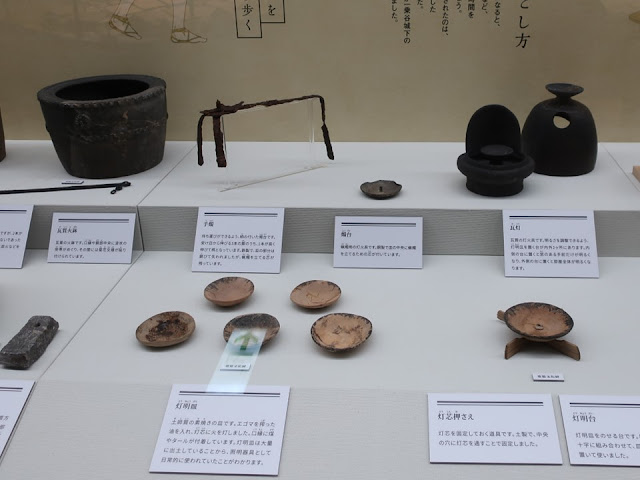Asakura Family were warlord during the internal wartime in the 15th and the 16th centuries. They were based in Ichijodani, which is a valley and was easy to defend. The family summoned their retainers, merchants and craftsmen. They prospered around a hundred years until Oda Nobunaga destroyed them in 1573.
The huge museum is near Ichijodani site. It
shows us life of residents more than one of samurais. I'm happy because
people's life is the theme of my blog.
越前の戦国大名・朝倉氏は、防御に適した一乗谷に家臣や商工業者を住ませ、織田信長に滅ぼされる1573年まで、5代約百年にわたる繁栄を築きしました。
遺跡の近くに、巨大な一乗谷朝倉氏遺跡博物館があります。武家の歴史より、城下に住んだ人びとの暮らしについて、たくさん展示されています。本ブログのテーマに合っていてありがたいです。
Article of the site、一乗谷遺跡の記事:Ichijodani Asakura Family Site、一乗谷朝倉氏遺跡
Castle town from the Sengoku Period (internal wartime) / Life in Ichijodani、戦国城下町 / 一乗谷の暮らし
Unearthed articles and life of people are exhibited. Residents were not ordinary people but important ones who were summoned by lord. It is assumed that more than ten thousand people lived. Retainers lived there, so his deputy official resided his land.
発掘品をもとに、そこに生きた人びとの暮らしが紹介されています。人びとといっても、領主に集住を命じられた者たちで、上級国民ともいえます。その数は、1万人を下らないと推定されています。家臣も城下に住み郷村には代官を置きました。
There are many pictures which illustrate people’s life. It is written, “Unearthed tools tell eloquently how undocumented nameless people ate well, worked hard, and played joyfully, living their daily lives.” I like the caption!
城下の暮らしが、多くの発掘物とともに絵で説明されています。「(暮らしていた人の)ほとんどは文字資料に記されることもない、名もなき人々です。出土した道具類は、よく食べ、よく働き、よく遊んだ当時の人々の暮らしを雄弁に語ってくれます」と書かれています。いいですねえ。
It was a wartime, so the tools of gun manufactures and blacksmith are unearthed. On the other hand, tools of Buddhist rosary craftsmen were also found such as defective crystal beads. I reckon people strongly wished safety under the war.
戦国らしく、鍛冶や鉄砲職人の遺物が発掘されています。その一方で、数珠を作る念珠挽という職人の遺跡も発掘されています。作り損なった水晶玉など出ています。安全・平和への願いを感じますね。
Craftsman district, they lived here and made various products in their own houses.
職人町、職人が住み様々な品物を作りました。
A day in the castle town: tools for taking good care of appearance such as combs are displayed. Being neat was important even during the wartime.
「城下の一日」のコーナー:櫛など身だしなみを整える道具の展示です。戦時下でも大切なことですね。
A mortar and knives. Picture helps us understand what it was.
包丁やすり鉢、絵を付けた分かりやすい展示です。
Tableware. They ate two times a day (morning and evening). Ordinary people ate rice, a soup and a dish. Meanwhile, samurai ate several kinds of dishes. They used chopstick rest (lower left), which is a simple one but was designated as an important cultural asset. Many cultural assets are displayed.
食膳具です。食事は朝夕の二回、庶民は一汁一菜(ご飯と汁物・おかず)、武士は数種類の料理を食していました。箸置き(耳皿)も使っています。素朴な品ですが、重要文化財でした。重要文化財がたくさん展示されています。
How to spend evening. Lighting equipment such as oil-lamp dishes are exhibited. It is written, “People probably spend their evening respectively such as eating, learning and playing.” Their life was not poor.
「夜の過ごし方」として灯明皿などの照明器具が展示されています。「食事や学問、遊びなど、人々はそれぞれの時間を過ごしたことでしょう」と書かれています。豊かですね。
Life in winter. Snow shovels, heaters and so on are exhibited. Those are almost same things which we used in the early 20th century.
「冬のくらし」として暖房や雪かきの器具が展示されています。昭和初期でも、同様の品々が使われていました。
Prayer of people. Not only a memorial tower (left edge) but also spinning tops and battledores are displayed. They used those toys to drive away demon from children and to pray for their healthy growth.
「人々の祈り」のコーナー:供養塔とともに、羽子板や独楽が展示されています。子どもの健康を願う魔除けの意味がありました。
A shuttle was considered as a demon; people hit it by the battledore. The name of spinning top(独楽=胡魔)means driving a demon away. People transferred bad matters of children to wooden boats and dolls, and floated on river which was rite to drive bad fortune away. All practices are connected with praying for healthy growth of children.
羽子板は鬼に見立てた羽根を突く遊び、独楽は「胡魔」とも書き、魔を祓う意味がありました。また、舟形や人形に子供の穢れを移して、厄災を祓いました。「祈り」に通じるのですね。
History of the Asakura family and the glorious Asakura culture、戦国大名朝倉氏の歴史・華麗なる朝倉文化
The photo above shows the menu of the feast in which Asakura entertained a younger brother of a shogun (military head). There were seventeen courses from the foods on the first course (a bird and so on) to the ones on the last course (sushi and so on). On the third course, seven trays were served (seafoods such as tai fish, river foods such as ayu fish and mountain foods such as mushrooms). How many hours did the feast last?
朝倉義景が足利義昭をもてなしたときの献立です。初献(鳥など)から十七献(鮎のすしなど)まであります。三献は、七の御膳まであり、鯛などの海の幸、鯉などの川の幸、椎茸などの山の幸が供されています。何時間かけて食べたのでしょうか。
The photo above is the most attractive exhibit “Asakura Residence Life-sized model”.
朝倉館原寸再現。目玉展示です。
We can rent costumes back then. It cost only five-hundred yen, cheap!
戦国衣装を借りられます。一着500円、安い!
A room for tea party、茶の湯座敷
Visited in October, 2023
Official website: https://asakura-museum.pref.fukui.lg.jp/en/
https://asakura-museum.pref.fukui.lg.jp/
(in Japanese, but much info.), accessed in May, 2024
Previous post (ruin in the same place)): Ichijodani
Asakura Family Site、一乗谷朝倉氏遺跡
Next post (museum in Nagano prefecture of central Japan, where I stay at present): Matsumoto City Museum、松本市立博物館


















Comments
Post a Comment